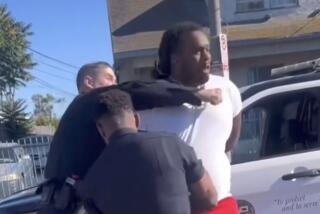It Takes a Community for Community Policing to Work
- Share via
We are now very close to the appointment of a new police chief for Los Angeles. The question again will be raised: Where is the Los Angeles Police Department headed?
Almost certainly, continued efforts toward community policing will be part of any new chief’s platform. But it is unclear just what “community policing” means. In fact, the term is increasingly confused with another, potentially conflicting strategy: “broken windows” policing. The difference is more than academic.
Community policing is a vague term meant to capture a variety of activities that improve police-community relations. The ideal here is to reach something approaching a partnership of equals in which each side learns from and compromises with the other. This model contrasts with the one that preceded it, in which officers cast themselves as the experts and sought only minimal community input. The prototype here was Sgt. Joe Friday of TV’s “Dragnet,” who solicited “just the facts” when he engaged citizens.
Community policing also may contrast with broken windows policing in ways that the next LAPD chief should acknowledge when mapping the department’s direction. The broken windows approach encourages officers to deal aggressively with “quality of life” issues. The theory here is that such seemingly mundane factors as broken windows or aggressive panhandlers can signal a neighborhood decline that will breed more serious crimes.
This policing philosophy is in place most visibly in New York City, where it is credited for the drop in crime. The police argue that their efforts to clear streets of such annoyances as itinerant car window washers are helping to stop wider patterns of criminality.
This model of policing is gaining more and more adherents across the country, including many within the LAPD and, apparently, Mayor Richard Riordan. There is reason to suspect, therefore, that the next chief might well include the broken windows approach in his package of reforms.
But broken windows policing is not the same as community policing. Broken windows policing may involve increased police-community ties, but typically only on terms dictated by the police. Officers remain the experts in crime fighting and solicit community help for projects developed exclusively by the police.
This is not an equal partnership. There is little room in this model for the community to determine what the police will do or how the police will be evaluated. Community members are viewed by the police not as colleagues but as “eyes and ears” or sources of the information needed to achieve police-defined goals.
Broken windows policing may even increase police-community tensions. In New York City, for example, citizen complaints about the police skyrocketed when the more aggressive tactics were implemented. This is an aspect of New York’s experience that should give the LAPD pause, given the explosive history of police-community turmoil here.
There may well be communities in Los Angeles that would welcome police efforts to reduce quality of life offenses. But the philosophy of community policing holds that this is a decision that neighborhoods should make through open dialogue with officers. Communities should not, in other words, have patrol strategies foisted upon them by aloof and all-knowing police experts.
Community policing gained popularity in Los Angeles because in many parts of the city, relations between officers and citizens were tense. These relations are better, but more can be done to improve the nature and equity of the police-community dialogue. Broken windows policing might help this dialogue, but it also might fracture it. The next chief should approach it warily.
More to Read
Sign up for Essential California
The most important California stories and recommendations in your inbox every morning.
You may occasionally receive promotional content from the Los Angeles Times.










